|
Nokia Corporation (OMX: NOK1V , NYSE: NOK, FWB: NOA3) is a multi-national communications corporation, focused on the key growth areas of wired and wireless telecommunications. Nokia is currently the world's largest manufacturer of mobile telephones, with a global device market share of approximately 39% in Q3 of
2007. Nokia produces mobile phones for every major market segment and protocol, including GSM, CDMA, and W-CDMA (UMTS). The corporation also produces telecommunications network equipment for applications such as mobile and fixed-line voice telephony, ISDN, broadband access, voice over IP, and wireless LAN.

Nokia's headquarters are located in Espoo, a neighbouring city of Finland's capital Helsinki. It has R&D, manufacturing, and sales representation sites in many continents throughout the world. Nokia Research Center, the corporation's industrial research laboratories, has sites in Helsinki; Tampere; Toijala; Tokyo; Beijing; Budapest; Bochum; Palo Alto, California and Cambridge, Massachusetts. Major production factories are located at Salo, Finland; Beijing, China; Dongguan, China; Chennai, India; Komárom, Hungary and the Ruhr region at Germany. In March 2007, Nokia signed a memorandum with Cluj-Napoca City Council, Romania to open a new plant near the city in Jucu
commune. Nokia's Design Department remains in Salo.
Nokia plays a very large role in the economy of Finland. Nokia is by far the largest Finnish company, accounting for about a third of the market capitalization of the Helsinki Stock Exchange (OMX Helsinki); a unique situation for an industrialized country.[6] It is an important employer in Finland and several small companies have grown into large ones as Nokia's subcontractors. Nokia increased Finland's GDP by more than 1.5 percent in 1999 alone. In 2004 Nokia's share of the Finland's GDP was 3.5 percent and accounted for almost a quarter of Finland's exports in 2003. In 2006, Nokia generated revenue that for the first time exceeded the state budget of Finland. This has led some to refer to Finland as "Nokialand."
Finns have ranked Nokia many times as the best Finnish brand and employer. Nokia is listed as the 5th most valuable global brand in BusinessWeek's Best Global Brands list of 2007 (1st non-US
company), the 20th most admirable company worldwide in Fortune's World's Most Admired Companies list of 2007 (1st in network communications, 4th non-US
company), and is the world's 119th largest company in Fortune Global 500 list of 2007, up from 131 of the previous
year.
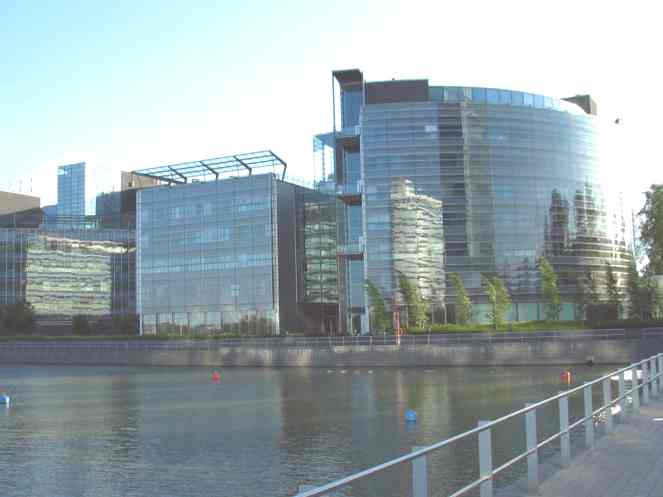
Nokia House, Nokia's headquarters located by the Gulf of Finland in Keilaniemi, Espoo, was constructed between 1995 and 1997. It is the working place of more than 1,000 Nokia employees.
History
Pre-telecommunications era
What is known today as Nokia was established in 1865 as a wood-pulp mill by Knut Fredrik Idestam on the banks of the Tammerkoski rapids in the town of Tampere, in south-western Finland. The company was later relocated to Nokia by the Nokianvirta river, which had better resources for hydropower production. That's where the company also got its name that is still used today. The name of the town of Nokia originated from the river which flowed through the town. The river itself, Nokianvirta, was named after the old Finnish word originally meaning a dark, furry animal that was locally known as the nokia, or sable, later pine marten.
Finnish Rubber Works established its factories in the beginning of 20th century nearby and began using Nokia as its brand. Shortly after World War I Finnish Rubber Works acquired Nokia Wood Mills as well as Finnish Cable Works, a producer of telephone and telegraph cables. All these three companies were merged into the Nokia Corporation in 1967.
The Nokia Corporation that was created in the 1967 fusion was involved in many sectors, producing at one time or another paper products, bicycle and car tyres, footwear (including Wellington boots), personal computers, communications cables, televisions, electricity production, capacitors, aluminum, etc.
Telecommunications era
The seeds of the current incarnation of Nokia were planted with the founding of the electronics section of the cable division in the 1960s. In the 1967 fusion, that section was separated into its own division, and began manufacturing telecommunications equipment.
Since 1964 had developed VHF-radio simultaneously with Salora Oy, which later in 1971 also developed the ARP-phone. In 1979 the merger of these two companies resulted in the establishment of Mobira Oy and three years later it launched the NMT phone. Nokia bought Salora Oy in 1984 and now owning 100% of the company, changed the company's name to Nokia-Mobira Oy. In 1988, Jorma Nieminen, resigning from the post of CEO of the mobile phone unit, along with two other employees from the unit, started a notable mobile phone company of their own, Benefon Oy. One year later, Nokia Mobira Oy became Nokia Mobile Phones and in 1991 the first GSM phone was launched.
In the 1970s, Nokia became more involved in the telecommunications industry by developing the Nokia DX200, a digital switch for telephone exchanges. In 1982, a DX200 switch became the world's first digital telephone switch to be put into operational use. The DX200 became the workhorse of the network equipment division. Its modular and flexible architecture enabled it to be developed into various switching products.
For a while in the 1970s, Nokia's network equipment production was separated into Telefenno, a company jointly owned by the parent corporation and by a company owned by the Finnish state. In 1987 the state sold its shares to Nokia and in 1992 the name was changed to Nokia Telecommunications.
In the 1970s and 1980s Nokia developed the Sanomalaitejärjestelmä ("Message device system") for Finnish Defence Forces.
In the 1980s, Nokia produced a series of personal computers called
MikroMikko. However, the PC division was sold to ICL, which later became part of Fujitsu. That company later transferred its personal computer operations to Fujitsu Siemens Computers, which shut down its only factory in Finland (in the town of Espoo, where computers had been produced since the 1960s) at the end of March
2000, thus ending large-scale PC manufacturing in the country.
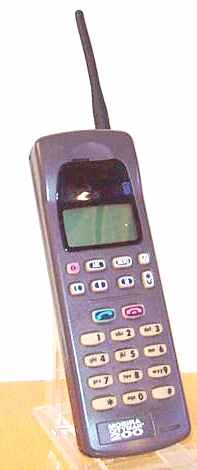
Nokia's early model Mobira Cityman 200
First mobile phones
Nokia had been producing commercial and military mobile radio communications technology since the 1960s and later began developing mobile phones for the Nordic Mobile Telephone (NMT) network standard that went online in the 1980s.
In 1982, Nokia (then Mobira) introduced its first car phone, the Mobira Senator for NMT 450 networks. The Mobira Talkman, launched in 1984, was the world's first transportable phone. In 1987, Nokia introduced the world's first handheld phone, the Mobira Cityman 900. When the Mobira Senator of 1982 had weighed 9.8 kg (21.6 lb), and the Talkman just under 5 kg (11 lb), the Mobira Cityman weighed only 800 g (28 oz) with the battery and had a price tag of 24,000 Finnish marks (approximately EUR
4,560). Despite the high price, the first phones were almost snatched from the sales assistants’ hands. Initially, the mobile phone was a ‘yuppie’ product and a status symbol.
NMT was the world's first mobile telephony standard that enabled international roaming, and provided valuable experience for Nokia for its close participation in developing Global System for Mobile Communications (GSM). It is a digital standard which came to dominate the world of mobile telephony in the 1980s and 1990s, in mid-2006 accounting for about two billion mobile telephone subscribers in the world, or about 80% percent of the total, in more than 200 countries. The world's first commercial GSM call was made in 1991 in Helsinki over a Nokia-supplied network, by then Prime Minister of Finland Harri Holkeri, using a Nokia phone.
In the 1980s, during the era of its CEO Kari Kairamo, Nokia expanded into new fields, mostly by acquisitions. In the late 1980s and early 1990s, the corporation ran into serious financial problems, a major reason being its heavily loss-making television division. (These problems probably contributed to Kairamo taking his own life in 1988.) Nokia responded by streamlining its telecommunications divisions, and by divesting itself of the television and PC divisions. Jorma Ollila, who became the CEO in 1992, made a strategic decision to concentrate solely on telecommunications. Thus, during the rest of the 1990s, Nokia continued to divest itself of all of its non-telecommunications divisions.
The exploding worldwide popularity of mobile telephones, beyond even Nokia's most optimistic predictions, caused a logistics crisis in the mid-1990s. This prompted Nokia to overhaul its entire logistics operation. Logistics continues to be one of Nokia's major advantages over its rivals, along with greater economies of scale.
In the new millennium
In 2004, the troubles of the networks equipment division caused the corporation to resort to similar streamlining practices on that side, with layoffs and organizational restructuring. This, however, diminished Nokia's public image in Finland, and produced a number of court cases along with an episode of a documentary television show critical towards
Nokia.
Despite these occasional crises, Nokia has been phenomenally successful in its chosen field. This growth has come mostly during the era of Jorma Ollila and his team of about half a dozen close colleagues. In June 2006, this era came to an end with Ollila leaving the CEO position to become the chairman of Shell. The new CEO of Nokia is Olli-Pekka Kallasvuo.
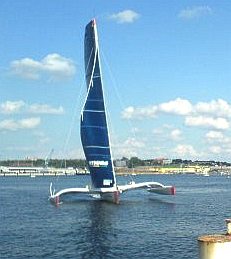
On February 2006 Nokia and Sanyo announced a MOU to create a joint venture addressing the CDMA handset business. A few months later, in June, both companies announced ending their negotiations without agreement. Nokia also stated their decision to pull out of CDMA R&D, with the intention to continue CDMA business in selected
markets.
On February 10, 2006, Nokia acquired Intellisync Corporation, a provider of data and PIM synchronization software.
On June 19, 2006, Nokia and Siemens AG announced the companies are to merge their mobile and fixed-line phone network equipment businesses to create one of the world's largest network firms. Both companies will have a 50% stake in the infrastructure company, to be headquartered in the Helsinki area, and to be called Nokia Siemens Networks. The companies predict annual sales of €16 billion and cost savings of €1.5 billion a year by 2010. About 20,000 Nokia employees will be transferred to this new company.
In May 2007 Nokia announced its Nokia 1100, with over 200 million units shipped, is the best-selling mobile phone of all time and the world's top-selling consumer electronics
product.
In July 2007 Nokia acquired all assets of Twango, the comprehensive media sharing solution for organizing and sharing photos, videos and other personal
media.
In August 2007 Nokia launched a series of web services under the brand name Ovi that allows users to download games, maps and music directly to their phones.
In September 2007 Nokia announced their intention to acquire Enpocket, a supplier of mobile advertising technology and
services.
In October 2007 Pending shareholder and regulatory approval, Nokia acquires Navteq, a U.S.-based supplier of digital mapping data, for a price of
$8.1B.
Product divisions
Nokia comprises four business groups: Mobile Phones, Multimedia, Enterprise Solutions and Networks, plus various horizontal entities such as Customer and Market Operations, and Technology Platforms.
On June 20, 2007, Nokia announced that it would reorganize into three business units, effective January 1, 2008:
Devices: This division combines its existing mainline mobile phones division with the separate subdivisions manufacturing Multimedia (N-Series) and Enterprise (E-Series) class devices, headed by Kai Öistämö.
Services and Software: This combines the existing Technology Platforms division with other services monetized independently, headed by Niklas Savander.
Markets: The successor organization to Nokia's Customer and Market Operations division, represents the sales, marketing, integration and strategy functions of the company, led by Anssi
Vanjoki.
Mobile Phones
Evolution of the Nokia CommunicatorNokia's Mobile Phones division provides the general public with mobile voice and data products across a wide range of mobile devices. The division aims to target primarily high-volume category sales of mobile phones and devices, with consumers being the most important customer segment. The devices are based on GSM/EDGE, 3G/WCDMA and CDMA cellular technologies.
Nokia believes that design, brand, ease of use and price are mainstream mobile phones' most important considerations to customers. Nokia's product portfolio includes camera phones with features such as megapixel cameras and MP3 players which appeal to the mass market.
In the first quarter of 2006 Nokia sold over 15 million MP3 capable mobile phones, which means that Nokia is not only the world's leading supplier of mobile phones and digital cameras (as most of Nokia's mobile telephones feature digital cameras, it is also believed that Nokia has recently overtaken Kodak in camera production making it the largest in the world), Nokia is now also the leading supplier of digital audio players (MP3 players). Nokia aims to sell 80 million music phones by the end of 2006, outpacing sales of devices such as the iPod from
Apple.
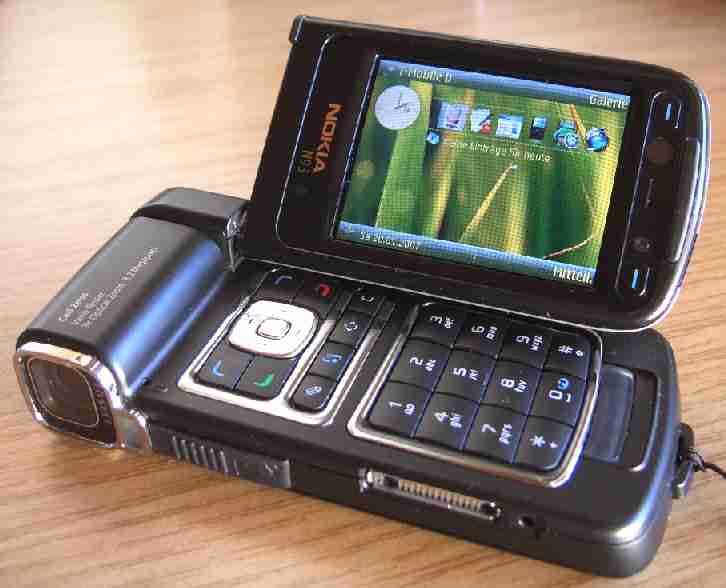
The Nokia N93, an example of Nokia's Nseries multimedia product
lineup.
Multimedia
The Multimedia division's purpose is to design devices and applications that bring multimedia experiences to their customers. These devices allow people to create, access and consume multimedia, as well as share their experiences with others. The devices are included with a wide range of connectivity such as GSM, 3G/WCDMA, WLAN and Bluetooth. Nokia Multimedia Nseries extensively uses Symbian OS.
The Multimedia group also works with other companies outside the telecommunications industry to make advances in the technology and bring new applications and possibilities in areas such as Internet services, optics, music synchronization and streaming media.
Loudeye
In August 2006, Nokia acquired online music distributor Loudeye Corp for $60m. The company has been developing this into an online music service in the hope of using it to generate handset sales. The service is expected to launch in late 2007 and would rival
iTunes.
MOSH
In August 2007, Nokia launched their new social network, dubbed MOSH. MOSH by Nokia is the first-ever social network built by a handset manufacturer. MOSH aims to bring social, media-based networks to the mobile environment. Users can upload, download, share, and bookmark a variety of media - audio files, video files, documents, applications, games,
images.
Enterprise Solutions
As the name implies, the Nokia Enterprise Solutions offers businesses, corporations and institutions a broad range of products and solutions, such as enterprise-grade mobile devices, underlying security infrastructure, software and services. Nokia also works with a range of companies to provide network security, bring mobilized corporate e-mail and extend corporate telephone systems to work with Nokia’s mobile devices.
Nokia Siemens Networks
Nokia Siemens Networks (previously Nokia Networks) provides mobile network infrastructure, communications and networks service platforms, as well as professional services to operators and service providers. Networks focuses in: GSM, EDGE, 3G/WCDMA and WiMAX radio access networks; core networks with increasing IP and multiaccess capabilities; and services.
At the end of 2005, Nokia Networks had more than 150 mobile network customers in more than 60 countries, with its systems serving in excess of 400 million subscribers.
On June 19, 2006 Nokia and Siemens AG announced the companies are to merge their mobile and fixed-line phone network equipment businesses to create one of the world's largest network firms, called Nokia Siemens Networks. The Nokia Siemens Networks brand identity, created by London and Tokyo based branding agency Moving Brands, was subsequently launched at the 3GSM World Congress in Barcelona in February
2007.
.mobi and the Mobile Internet
Nokia was the first proponent of a Top Level Domain (TLD) specifically for the mobile internet and, as a result, was instrumental in the launch of the .mobi domain name extension in September 2006 as an official backer.[24][25][26] Since then, Nokia has launched the largest mobile portal, Nokia.mobi, which receives over 100 million visits a month.[27] It followed that with the launch of a mobile Ad Service to cater to the growing demand for mobile advertisement.[28]
Corporate affairs
Historical logos
Nokia Company logo. Founded in Tampere in 1865, logo 1966.
Nokia – Finnish Rubber Works Ltd, founded in Helsinki in 1898.
Logo 1965–1966.
The Nokia "arrows" logo before its Connecting People logo.
Nokia introduced its "Connecting People" slogan.
The current logo's slogan uses Nokia's proprietary Nokia font. This earlier font shown here was Times Roman SC (Small
Caps).
Corporate governance
Nokia headquarters in Keilaniemi, Espoo.The operations of Nokia are managed by the Group Executive Board, left, under the direction of the Board of Directors, right. The Chairman and the rest of the Group Executive Board members are appointed by the Board of Directors. Only the Chairman of the Group Executive Board can belong to both, the Board of Directors and the Group Executive Board. The operations of the company are managed within the framework set by the Finnish Companies
Act, Nokia's Articles of Association and Corporate Governance
Guidelines, and related Board adopted charters.
Group Executive Board
Olli-Pekka
Kallasvuo (Chairman), b. 1953
President, CEO and Group Executive Board Chairman of Nokia
Corporation since June 1, 2006
Member of the Nokia Board of Directors since May 3, 2007
With Nokia 1980–1981, rejoined 1982, Group Executive Board
member since 1990 |
Robert Andersson,
b. 1960
Executive Vice President, Customer and Market Operations
Joined Nokia 1985, Group Executive Board member since 2005 |
/ Simon
Beresford-Wylie, b. 1958
Chief Executive Officer, Nokia Siemens Networks
Joined Nokia 1998, Group Executive Board member since 2005 |
Timo Ihamuotila,
b. 1966
Head of Sales and Portfolio Management for Nokia Mobile Phones
With Nokia 1993–1996, rejoined 1999, Group Executive Board
member since 2007 |
Mary T. McDowell,
b. 1964
Executive Vice President and General Manager of Enterprise
Solutions
Joined Nokia 2004, Group Executive Board member since 2004 |
Hallstein Mørk,
b. 1953
Executive Vice President, Human Resources
Joined Nokia 1999, Group Executive Board member since 2004 |
Dr. Tero Ojanperä,
b. 1966
Executive Vice President, Chief Technology Officer
Joined Nokia 1990, Group Executive Board member since 2005 |
Niklas Savander,
b. 1962
Executive Vice President, Technology Platforms
Joined Nokia 1997, Group Executive Board member since 2006 |
Richard A.
Simonson, b. 1958
Executive Vice President, Chief Financial Officer
Joined Nokia 2001, Group Executive Board member since 2004 |
Veli Sundbäck,
b. 1946
Executive Vice President, Corporate Relations and
Responsibility of Nokia Corporation
Joined Nokia 1996, Group Executive Board member since 1996 |
Anssi Vanjoki, b.
1956
Executive Vice President and General Manager of Multimedia
Joined Nokia 1991, Group Executive Board member since 1998 |
Dr. Kai Öistämö,
b. 1964
Executive Vice President and General Manager of Mobile Phones
Joined Nokia 1991, Group Executive Board member since 2005 |
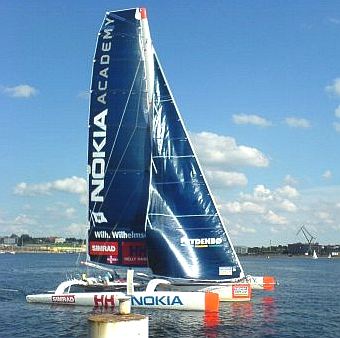
Board
of Directors
Jorma
Ollila (Chairman), b. 1950
Board member since 1995, Chairman of the Board of Directors
since 1999
Chairman of the Board of Directors of Royal
Dutch Shell PLC |
Dame
Marjorie Scardino (Vice Chairman), b. 1947
Board member since 2001
Chairman of the Corporate Governance and Nomination Committee,
Member of the Personnel Committee
Chief Executive Officer and member of the Board of Directors
of Pearson PLC |
Georg
Ehrnrooth, b. 1940
Board member since 2000
Member of the Audit Committee, Member of the Corporate
Governance and Nomination Committee |
Lalita
D. Gupte, b. 1948
Board member since 2007
Member of the Audit Committee
Non-executive Chairman of the ICICI Venture Funds Management
Co Ltd. |
Daniel
R. Hesse, b. 1953
Board member since 2005
Member of the Personnel Committee
Chairman and Chief Executive Officer, Embarq Corporation |
Dr.
Bengt Holmström, b. 1949
Board member since 1999
Paul A. Samuelson Professor of Economics at Massachusetts
Institute of Technology,
joint appointment at the MIT Sloan School of Management |
Dr.
Henning Kagermann, b. 1947
Board member since 2007
CEO and Chairman of the Executive Board of SAP AG |
Olli-Pekka
Kallasvuo, b. 1953
Board member since 2007
President and CEO of Nokia Corporation |
Per
Karlsson, b. 1955
Board member since 2002, Independent Corporate Advisor
Chairman of the Personnel Committee, Member of the Corporate
Governance and Nomination Committee |
Keijo
Suila, b. 1945
Board member since 2006
Member of the Audit Committee |
Vesa
Vainio, b. 1942
Board member since 1993
Member of the Audit Committee |
Corporate culture
Nokia's official corporate culture manifesto, The Nokia Way, emphasises the speed and flexibility of decision-making in a flat, networked organization, although the corporation's size necessarily imposes a certain amount of bureaucracy. Equality of opportunities and openness of communication are also stressed, along with management leadership and employee participation.
Nokia is a progressive and forward-thinking mobile technology group that spends a significant amount of its revenue on research and development, and prides itself on often being the first to market with new products and applications.
The official business language of Nokia is English. All documentation is written in English, and is used in official intra-company spoken communication and e-mail.
Until May 2007, the Nokia Values were Customer Satisfaction, Respect, Achievement, and Renewal. In May 2007, Nokia redefined its values after initiating a series of discussions worldwide as to what the new values of the company should be. Based on the employee suggestions, the new values were defined as: Engaging You, Achieving Together, Passion for Innovation and Very
Human.
Research cooperation with universities
University of Technology, Finland
Tampere University of Technology, Finland
Stanford University, United States
Massachusetts Institute of Technology, United States
University of Cambridge, United Kingdom
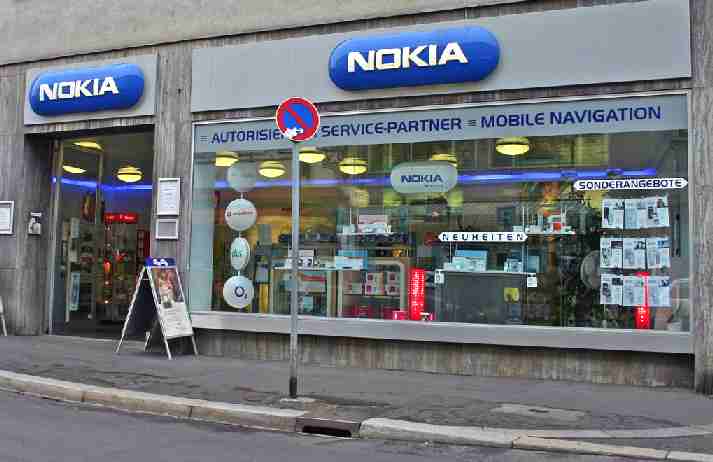
A Nokia shop in Würzburg, Germany. Helsinki
LINKS
and REFERENCE
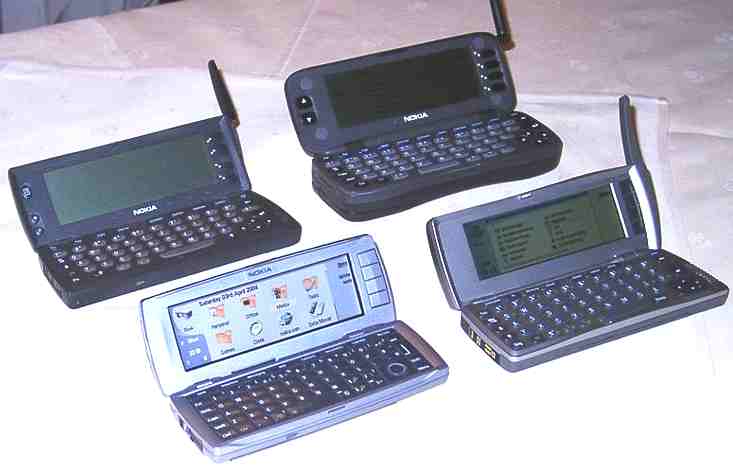
Why
not have a look at some of the mobiles that can deliver it all. You can
get market-leading Nokias and Sony Ericssons, powerful Motorolas, sexy
LGs and more. If you don't find what you're looking for - shop
around on our free A to Z.
FIND
YOUR PERFECT PHONE A - Z
No
matter what style, design or features you need on your phone, it pays
to shop for a good deal ...................
Finding the right
mobile phone and airtime package from numerous high street and online
dealers can prove to be an overwhelming challenge.
However, there’s more to a search than just finding a good looking
phone. You need to ensure you get a reliable service and sensibly priced
airtime. We therefore recommend you see our extensive Phone
Guide as a quick mission briefing before buying.

Mobile
refreshment for better communicators
......

330ml
Earth
Can - the World in Your Hand
|








